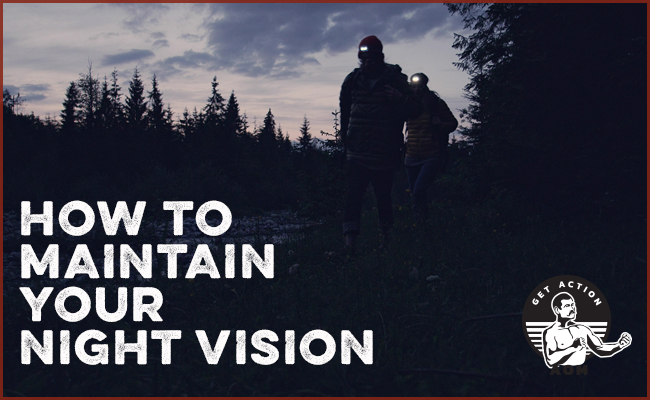
Whether you’re hunting wild boar at night, taking a moonlit walk through the woods, running some kind of covert operation, or simply trying to find the bathroom in an unfamiliar house or hotel, it can be advantageous to be able to see well in the dark.
You could fire up a flashlight to accomplish that purpose, but that has its disadvantages, including letting the thing you’re hunting know where you are, and, ironically, actually diminishing your ability to see in the dark.
You could also put on some fancy night-vision goggles if you wanted to get high-tech about it and had the money.
But your natural, naked eye has its own night-vision capabilities that are actually pretty top-notch — if you know how to enhance and harness them.
How We See in the Dark
Understanding how we see in the dark can better help us understand what we can do to maintain our vision at night. Below we walk you through a thumbnail sketch of how the human eye sees in low-light environments:
Pupil. Think of the pupil as the aperture on a camera. It’s what allows light to enter our eyes. The wider the pupil, the more light can come in; the narrower the pupil, the less light can enter.
Just as the aperture on a camera will open wide in low-light environments to allow more light in, so too will your pupil dilate — open wide — in dark situations.
You may have thought of this widening/narrowing of the pupil as the only mechanism by which your eyes adjust to the dark. But this is just the first step in this process, and not even the most significant one. Human night vision has more to do with the eye’s . . .
Rods and cones. After light passes through the pupil, it goes to the back of our eyeball and hits a thin layer of sensory membrane called the retina. Sticking with the old-school camera analogy, think of the retina as the camera’s film. It’s where our eyes start putting together nerve signals to send to our brains.
The retina is covered with two types of photoreceptors called rods and cones. They’re called rods and cones because those are the shapes they respectively take.
Rods work best in low-level light. They just need a few photons of light to be activated. When we’re looking around in low-light environments, our eyes primarily use rods to see things. The downside of rods is that they don’t see color. That’s why when you’re seeing in the dark, things look more grayscale, and colors don’t pop. Everything is kind of muted.
Cones require a lot more light to be activated. We have three types of cones: red, blue, and green. A combination of these different cones being activated allows us to see in color. Most of our cones are packed in a small part of the retina called the fovea, which is at the very back of the eyeball and allows us to see images in detail.
Photopigments, specifically rhodopsin. Both rods and cones contain light-sensitive chemicals called photopigments. These photopigments convert light energy that hits the retina into electrical activity so that our brains can decipher what we’re seeing. Going back to our camera analogy, think of photopigments as the chemicals that help develop your film.
Rods contain a photopigment called rhodopsin; cones contain a photopigment called photopsin.
Rhodopsin is what allows us to see at night.
But as soon as the rhodopsin is exposed to high-light levels, it decomposes (aka photobleaches), reducing our sensitivity to light in low-light conditions, meaning we can’t see as well in the dark. The brighter the light, the more the rhodopsin gets bleached.
Once your eyes are exposed to less light, the rhodopsin starts to regenerate in your rods. It takes about 30 minutes for rhodopsin to completely restore, bringing you back to optimal night vision. Even though it takes a half hour for rhodopsin to fully regenerate, your eyes’ ability to see in the dark will start to improve as soon as they stop being exposed to the high levels of light that caused their rhodopsin to decompose in the first place. You’ll notice that your low-light vision will slowly get better and better the longer you get used to the lower-light levels.
If you’ve ever experienced going from a bright sunny day outside to back inside your house, and everything looked really dark for
No comments:
Post a Comment